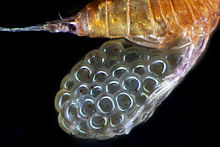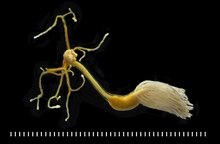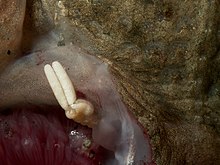Copepod
| Copepod Temporal range:
Likely early Paleozoic origin
| |
|---|---|

| |
| Scientific classification | |
| Domain: | Eukaryota |
| Kingdom: | Animalia |
| Phylum: | Arthropoda |
| Superclass: | Multicrustacea |
| Class: | Copepoda H. Milne-Edwards, 1840 |
| Orders | |
| |
Copepods (
As with other crustaceans, copepods have a
Classification and diversity
Copepods are assigned to the class Copepoda within the superclass Multicrustacea in the subphylum Crustacea.[2] An alternative treatment is as a subclass belonging to class Hexanauplia.[3] They are divided into 10 orders. Some 13,000 species of copepods are known, and 2,800 of them live in fresh water.[4]
Characteristics


Copepods vary considerably, but are typically 1 to 2 mm (1⁄32 to 3⁄32 in) long, with a teardrop-shaped body and large
Like other crustaceans, copepods possess two pairs of antennae; the first pair is often long and conspicuous.Free-living copepods of the orders Calanoida, Cyclopoida, and Harpacticoida typically have a short, cylindrical body, with a rounded or beaked head, although considerable variation exists in this pattern. The head is fused with the first one or two
Because of their small size, copepods have no need of any heart or circulatory system (the members of the order Calanoida have a heart, but no blood vessels), and most also lack gills. Instead, they absorb oxygen directly into their bodies. Their excretory system consists of maxillary glands.
Behavior
The second pair of cephalic appendages in free-living copepods is usually the main time-averaged source of propulsion, beating like oars to pull the animal through the water. However, different groups have different modes of feeding and locomotion, ranging from almost immotile for several minutes (e.g. some harpacticoid copepods) to intermittent motion (e.g., some cyclopoid copepods) and continuous displacements with some escape reactions (e.g. most calanoid copepods).

Some copepods have extremely fast escape responses when a predator is sensed, and can jump with high speed over a few millimetres. Many species have neurons surrounded by myelin (for increased conduction speed), which is very rare among invertebrates (other examples are some annelids and malacostracan crustaceans like palaemonid shrimp and penaeids). Even rarer, the myelin is highly organized, resembling the well-organized wrapping found in vertebrates (Gnathostomata). Despite their fast escape response, copepods are successfully hunted by slow-swimming seahorses, which approach their prey so gradually, it senses no turbulence, then suck the copepod into their snout too suddenly for the copepod to escape.[9]
Several species are bioluminescent and able to produce light. It is assumed this is an antipredatory defense mechanism.[10]
Finding a mate in the three-dimensional space of open water is challenging. Some copepod females solve the problem by emitting pheromones, which leave a trail in the water that the male can follow.[11] Copepods experience a low Reynolds number and therefore a high relative viscosity. One foraging strategy involves chemical detection of sinking marine snow aggregates and taking advantage of nearby low-pressure gradients to swim quickly towards food sources.[12]
Diet
Most free-living copepods feed directly on phytoplankton, catching cells individually. A single copepod can consume up to 373,000 phytoplankton per day.[13] They generally have to clear the equivalent to about a million times their own body volume of water every day to cover their nutritional needs.[14] Some of the larger species are predators of their smaller relatives. Many benthic copepods eat organic detritus or the bacteria that grow in it, and their mouth parts are adapted for scraping and biting. Herbivorous copepods, particularly those in rich, cold seas, store up energy from their food as oil droplets while they feed in the spring and summer on plankton blooms. These droplets may take up over half of the volume of their bodies in polar species. Many copepods (e.g., fish lice like the Siphonostomatoida) are parasites, and feed on their host organisms. In fact, three of the 10 known orders of copepods are wholly or largely parasitic, with another three comprising most of the free-living species.[15]
Life cycle

Most nonparasitic copepods are holoplanktonic, meaning they stay planktonic for all of their lifecycles, although harpacticoids, although free-living, tend to be benthic rather than planktonic. During mating, the male copepod grips the female with his first pair of antennae, which is sometimes modified for this purpose. The male then produces an adhesive package of sperm and transfers it to the female's genital opening with his thoracic limbs. Eggs are sometimes laid directly into the water, but many species enclose them within a sac attached to the female's body until they hatch. In some pond-dwelling species, the eggs have a tough shell and can lie dormant for extended periods if the pond dries up.[8]
Eggs hatch into nauplius larvae, which consist of a head with a small tail, but no thorax or true abdomen. The nauplius moults five or six times, before emerging as a "copepodid larva". This stage resembles the adult, but has a simple, unsegmented abdomen and only three pairs of thoracic limbs. After a further five moults, the copepod takes on the adult form. The entire process from hatching to adulthood can take a week to a year, depending on the species and environmental conditions such as temperature and nutrition (e.g., egg-to-adult time in the calanoid Parvocalanus crassirostris is ~7 days at 25 °C (77 °F) but 19 days at 15 °C (59 °F).[16]
Biophysics
Copepods jump out of the water - porpoising. The biophysics of this motion has been described by Waggett and Buskey 2007 and Kim et al 2015.[17]
Ecology

Planktonic copepods are important to global ecology and the carbon cycle. They are usually the dominant members of the zooplankton, and are major food organisms for small fish such as the dragonet, banded killifish, Alaska pollock, and other crustaceans such as krill in the ocean and in fresh water. Some scientists say they form the largest animal biomass on earth.[19] Copepods compete for this title with Antarctic krill (Euphausia superba). C. glacialis inhabits the edge of the Arctic icepack, especially in polynyas where light (and photosynthesis) is present, in which they alone comprise up to 80% of zooplankton biomass. They bloom as the ice recedes each spring. The ongoing large reduction in the annual ice pack minimum may force them to compete in the open ocean with the much less nourishing C. finmarchicus, which is spreading from the North Sea and the Norwegian Sea into the Barents Sea.[20]

Because of their smaller size and relatively faster growth rates, and because they are more evenly distributed throughout more of the world's oceans, copepods almost certainly contribute far more to the
About half of the estimated 14,000 described species of copepods are
Copepods as parasitic hosts
In addition to being parasites themselves, copepods are subject to parasitic infection. The most common parasites are marine dinoflagellates of the genus Blastodinium, which are gut parasites of many copepod species.[27][28] Twelve species of Blastodinium are described, the majority of which were discovered in the Mediterranean Sea.[27] Most Blastodinium species infect several different hosts, but species-specific infection of copepods does occur. Generally, adult copepod females and juveniles are infected.
During the naupliar stage, the copepod host ingests the unicellular dinospore of the parasite. The dinospore is not digested and continues to grow inside the intestinal lumen of the copepod. Eventually, the parasite divides into a multicellular arrangement called a trophont.[29] This trophont is considered parasitic, contains thousands of cells, and can be several hundred micrometers in length.[28] The trophont is greenish to brownish in color as a result of well-defined chloroplasts. At maturity, the trophont ruptures and Blastodinium spp. are released from the copepod anus as free dinospore cells. Not much is known about the dinospore stage of Blastodinium and its ability to persist outside of the copepod host in relatively high abundances.[30]
The copepod Calanus finmarchicus, which dominates the northeastern
Freshwater copepods of the
Evolution

Despite their modern abundance, due to their small size and fragility, copepods are extremely rare in the fossil record. The oldest known fossils of copepods are from the late Carboniferous (Pennsylvanian) of Oman, around 303 million years old, which were found in a clast of bitumen from a glacial diamictite. The copepods present in the bitumen clast were likely residents of a subglacial lake which the bitumen had seeped upwards through while still liquid, before the clast subsequently solidified and was deposited by glaciers. Though most of the remains were undiagnostic, at least some likely belonged to the extant harpacticoid family Canthocamptidae, suggesting that copepods had already substantially diversified by this time.[33] Possible microfossils of copepods are known from the Cambrian of North America.[34][35] Transitions to parasitism have occurred within copepods independently at least 14 different times, with the oldest record of this being from damage to fossil echinoids done by cyclopoids from the Middle Jurassic of France, around 168 million years old.[36]
Practical aspects
In marine aquaria
Live copepods are used in the saltwater aquarium hobby as a food source and are generally considered beneficial in most reef tanks. They are scavengers and also may feed on algae, including
Water supplies
Copepods are sometimes found in public main water supplies, especially systems where the water is not mechanically filtered,
Copepods have been used successfully in
The copepods can be added to water-storage containers where the mosquitoes breed.
The presence of copepods in the
When a group of
In popular culture
The Nickelodeon television series SpongeBob SquarePants features a copepod named Sheldon J. Plankton as a recurring character.[47]
See also
- Hunting copepods
- Particle (ecology)
- World Association of Copepodologists
References
- ISBN 9780871692405.
- ^ World of Copepods Database. Walter, T.C.; Boxshall, G. (eds.). "Copepoda". World Register of Marine Species. Retrieved 22 January 2023.
- ^ "WoRMS - World Register of Marine Species - Copepoda". www.marinespecies.org. Archived from the original on 2019-06-30. Retrieved 2019-06-28.
- S2CID 31727589.
- ISBN 9780195369748.
- ISBN 9780632055364.
- (PDF) from the original on 2019-07-12. Retrieved 2018-06-15.
- ^ ISBN 978-0-03-056747-6.
- ^ "Seahorses stalk their prey by stealth". BBC News. November 26, 2013. Archived from the original on November 22, 2017. Retrieved June 20, 2018.
- ^ A light in the dark: ecology, evolution and molecular basis of copepod bioluminescence
- ISBN 978-0-674-03116-6.
- S2CID 55896867.
- ^ "Small Is Beautiful, Especially for Copepods - The Vineyard Gazette". Archived from the original on 2018-09-07. Retrieved 2018-09-07.
- ^ "What makes pelagic copepods so successful? - Oxford Journals". Archived from the original on 2018-09-02. Retrieved 2018-09-02.
- PMID 34466296.
- ^ Thomas D. Johnson. 1987. Growth and regulation of a population of Parvocalanus crassirostris in Long Island, New York. Ph.D. Diss, SUNY Stony Brook.
- ISSN 2469-990X.
- PMID 22947621.
- Carl von Ossietzky University of Oldenburg. Archived from the originalon May 26, 2010. Retrieved December 8, 2009.
- ^ "Biodiversity: Pity the copepod". The Economist. June 16, 2012. pp. 8–9. Archived from the original on June 18, 2012. Retrieved 2012-06-19.
- .
- ^ David W. Pond; Geraint A. Tarling (13 June 2011). "Copepods share "diver's weight belt" technique with whales". British Antarctic Survey. Archived from the original on 5 January 2013. Retrieved November 20, 2012.
- PMID 34466296.
- ^ See photograph at "Blobfish / Psychrolutes microporos" (PDF). Census of Marine Life / NIWA. Archived from the original (PDF) on October 16, 2008. Retrieved December 9, 2007. Photograph taken by Kerryn Parkinson and Robin McPhee in June 2003.
- PMID 34466296.
- S2CID 31727589.
- ^ a b Edouard Chatton (1920). "Les Péridiniens parasites. Morphologie, reproduction, éthologie" (PDF). Arch. Zool. Exp. Gén. pp. 59, 1–475. plates I–XVIII. Archived (PDF) from the original on 2014-05-04. Retrieved 2014-10-22.
- ^ PMID 22973263.
- ^ .
- .
- .
- ^ "This Species is Close to Extinction and That's a Good Thing". Time. January 23, 2015. Archived from the original on May 24, 2015. Retrieved May 31, 2015.
- PMID 20975721.
- PMID 22307616.
- S2CID 128694987.
- PMID 34466296.
- ^ a b Drink Up NYC: Meet The Tiny Crustaceans (Not Kosher) In Your Tap Water Archived 2019-08-13 at the Wayback Machine. Time, September 2010, Allie Townsend.
- ^ Anthony DePalma (July 20, 2006). "New York's water supply may need filtering". The New York Times. Archived from the original on February 9, 2015. Retrieved October 12, 2010.
- ISBN 9781603272650.
- PMID 15728869.
- S2CID 7645668.
- ^ "OU Fact Sheet on NYC Water". Orthodox Union Kosher Certification. New York City: Orthodox Union. August 13, 2004. Archived from the original on May 28, 2013. Retrieved May 1, 2013.
- ^ Berger, Joseph (November 7, 2004) "The Water's Fine, But Is It Kosher?" Archived 2017-08-18 at the Wayback Machine, The New York Times
- ISBN 978-1602801950.
- ^ "NYC Tap Water Kosher Questions? OU Kosher Certification FAQs". OU Kosher Certification. Retrieved 2023-08-03.
- ^ "Hot Off the Hotline | STAR-K Kosher Certification". www.star-k.org. 23 August 2018. Retrieved 2023-08-03.
- Orange County Register. Archived from the originalon June 10, 2014.

